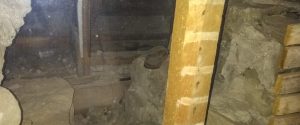This year I attended several of the 72 presentations of Historic Calgary Week (HCW), which ran from July 27 to August 6. Two of the most interesting involved old mansions: “Downton Abbey’s Calgary Connections,” and “Lougheed House: Reliving the Restoration.” Both explored the Upstairs-Downstairs relationships of grand houses of the early 20th century, revealing a few surprises along the way.
I was excited to find out about the connections between Downton Abbey and Calgary, but frankly, I would attend any lecture given by Doug Coates, my all-time favourite presenter. After 35 years as a social studies teacher and several years as an interpreter at Heritage Park, he has a vast knowledge of local history and presents information in an engaging and entertaining manner. Doug related many names and events shared between TV’s fictional Downton Abbey, its real-life double — Highclere Castle, and Calgary. A sample of these are given in his CBC Eyeopener interview.
While I was an avid fan of the TV series (how could you not love all those frocks, hats, and intrigue?) and picked up on some of the historical references, Doug explained these events in detail and showed their relevance to local history. The simplest example deals with the opening of the series, which occurs the morning after the Titanic sinks; Doug explained the relevance of this disaster to a Calgary couple and tied in broader Canadian economic ramifications as well.
The real-life Highclere Castle, where the series was filmed, is currently home to the eighth Earl of Carnarvon (not the fictional Earl of Grantham). The Earl’s second wife (Fiona) is the author of several history books about Highclere’s most interesting residents, which include the fifth Earl, who financed Howard Carter’s Egyptian excavations that led to the discovery of King Tut’s tomb in 1922. Doug also explained the vital connection between Highclere and the founding of our country: following discussions at Highclere with John A. MacDonald, George Etienne Cartier, and Alexander Galt, the fourth Earl took the British North America Act to the British Parliament in 1867, resulting in the creation of the Dominion of Canada on July 1st.
In short, this HCW offering ticked all my boxes with a super presenter, ties to archaeology, and information about local and Canadian history. If you are interested in finding out more about the Secrets of Highclere Castle, there is a program of that title on Netflix; you can also check out the Countess of Carnarvon’s website.
The other HCW presentation dealing with upper crust residences at the turn of the last century was a tour by Trudy Cowan, Executive Director Emeritus of Lougheed House. Sir James Lougheed and his wife Lady Isabella Hardisty Lougheed required a residence suited to their status; they needed to entertain visiting dignitaries in style. Their home, Beaulieu, hosted the Duke of Connaught (Governor General of Canada and son of Queen Victoria), his wife the Duchess, and their daughter Princess Patricia in 1912; the Prince of Wales (Prince Edward, son of George V) in 1919, 1923, and 1928; and Prince Erik of Denmark, also in 1928.
As Trudy detailed the architectural history of the house, from its construction in 1891, extension and renovation in 1907, redevelopment after the death of Lady Lougheed in 1938, and eventual rehabilitation, she explained the challenges of restoring the house in a manner that allowed it to tell its own story. For example, the footprint of the old furnace is now indicated by the pattern of new tiles in the basement. Additional difficulties included preserving or replicating the fine quality finishes in the house. As the restoration progressed, welcome surprises included the discovery of a hidden fireplace and the return of chairs that had been purchased from the home in the 1930s.
The tour included areas hidden from public view, including spaces used today for storage or offices, as well as the unbelievably steep and narrow servants’ staircases. The most intriguing items discovered during the restoration were the builders’ signatures on an attic timber and the concealed child’s shoe. Initially, the little shoe nestled among the rafters was a puzzle and it was removed from the house for study. During its absence, vandals damaged the house. It was then recognized that the shoe had not been mislaid by one of the Lougheed children, but was instead a charm to protect the house from harm. The shoe was returned to its resting place and is now protected behind glass.

Concealed child’s shoe now behind glass in original position.
If you would like to investigate the practice of concealing charms during building construction, visit this website. To learn more about Lougheed House and their current exhibit “Formed by Sand” go to their website. By the way, the excavation I conducted at Glenbow Ranch Provincial Park last summer is featured in the basement, along with historic photos and discussion of other sandstone quarries in the Calgary area.
These two HCW offerings highlighted historic mansions and the people who lived in them at the beginning of the 20th century. Surprisingly, they have a lot in common. Although Beaulieu is significantly smaller than Downton Abbey / Highclere Castle, it was the cream of the crop in early Alberta and both homes have hosted royalty. Both Highclere and Beaulieu contain not only the owners’ public and private spaces, and the servants’ domain, but also hidden compartments that were lost to time. Understanding each home and the functions of its component spaces helps foster a fuller grasp of past society. The class distinctions so clearly felt while traipsing through Beaulieu are better understood by watching Downton Abbey, which clearly articulates the codependent relationship between the Upstairs owners and the Downstairs servants.
This article was originally printed in the BERGEN NEWS and is being reprinted with permission.